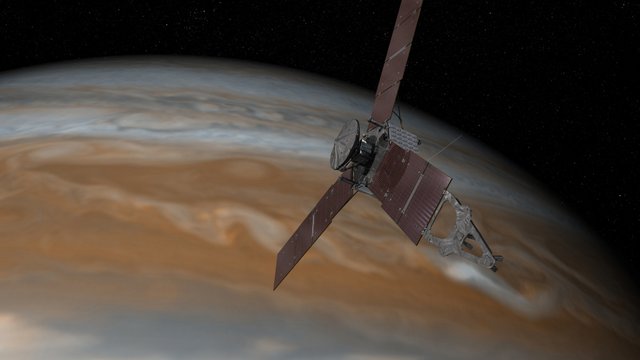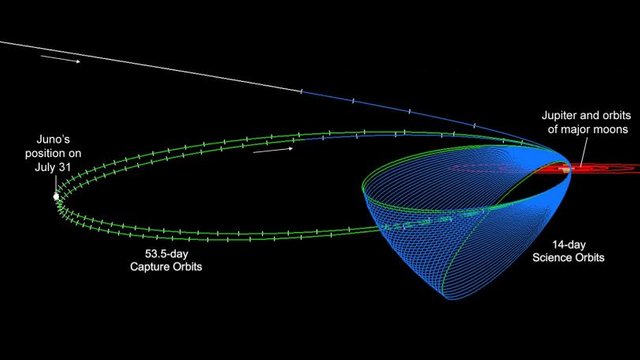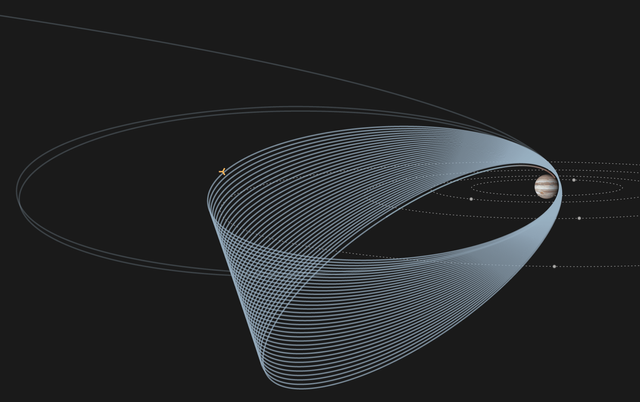Juno spacecraft will be continued in its current orbit at Jupiter
NASA’s Juno probe, which has been orbiting around Jupiter since 4th July, 2016, will remain moving in its current 53-day-long orbits, rather than getting closer to the gas giant. Being in current orbits, Juno will be able to achieve its scientific missions, while avoiding the risk of its balky engine. This mission could continue until 2021, as long as its systems will be operating and getting funded.

The original plan for the Juno probe was to circle around Jupiter twice in 53-day orbits, and then cut its orbital period to 14 days for the majority of its scientific mission. However, when Juno’s propulsion system got pressurized in October 2016, two helium check valves in the spacecraft’s main engine did not function as expected, resulting to delay the October burn. Juno’s telemetry signaled that the valves needed several minutes to be opened, while it opened within a few seconds during past main engine firings.

During its current 53-day-long orbit, Juno flies low over Jupiter’s cloud tops in its 14-day traverse, as close as about 4100 kilometers (2,600 miles). During these close approaches, the spacecraft investigated the planet’s origins, atmosphere, structure and magnetosphere. Scott Bolton, who is the project’s principal investigator and a planetary scientist at the Southwest Research Institute in Boulder in Colorado, says
“The science opportunities are truly better in the longer orbit.”
Thomas Zurbuchen, NASA’s associate administrator for science in Washington, D.C., said in a release
“Juno is healthy, its science instruments are fully operational, and the data and images we’ve received are nothing short of amazing. The decision to forego the burn is the right thing to do—preserving a valuable asset so that Juno can continue its exciting journey of discovery.”

According to its previous plan made by scientists, Juno had to complete its primary mission of 37 orbits in early 2018 including a move towards the planet. Now those same observations will be completed by the middle of 2021. In previous mission the spacecraft had no solar panels. But this time Juno has solar panels that could prevent the spacecraft from Jupiter’s radiation belt and extend its life.
The longer orbits may slow publication and stop the career growth of those scientists who are engaged in Juno’s team. Juno’s measurements of Jupiter’s gravity will be conducted in the second half of its mission, and till then Juno may be malfunctioned. Currently, Juno will be operating within the current budget plan until July 2018, when it will have completed 12 science orbits. The extended orbits could destroy resources collected during other planetary missions. It may stop the spacecraft achieving its planned scientific missions and collecting more data.

However, Juno has already collected spectacular pictures of the planet. Juno’s next approach to Jupiter will be happen on 27 March.
This post has been ranked within the top 50 most undervalued posts in the first half of Feb 19. We estimate that this post is undervalued by $4.36 as compared to a scenario in which every voter had an equal say.
See the full rankings and details in The Daily Tribune: Feb 19 - Part I. You can also read about some of our methodology, data analysis and technical details in our initial post.
If you are the author and would prefer not to receive these comments, simply reply "Stop" to this comment.